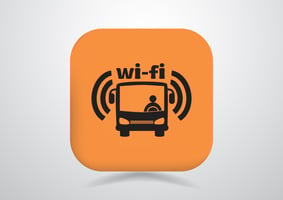Benefits of Wi-Fi and 5G for School Buses
published on September 28, 2021 by Sonia Mastros
School Bus WiFI, 5G for school buses, Wi-Fi for school buses
 One eternal problem with school bus rides, particularly in larger districts, is how much time they can take out of a student's day. When many students are riding for an hour or more every day, that can seriously cut into their time for studying or other academic activities.
One eternal problem with school bus rides, particularly in larger districts, is how much time they can take out of a student's day. When many students are riding for an hour or more every day, that can seriously cut into their time for studying or other academic activities.
This is why on-bus Internet access has become a major topic of school bus technology. With a combination of 5G cell service and an onboard WiFi router, a bus can provide its students with plenty of bandwidth, and encourage them to spend more time studying or doing homework while on the bus.
Is the upgrade worth it?
The Costs and Benefits of WiFi on School Buses
In terms of costs, it's fairly reasonable. The equipment needed for 5G access, WiFi routing, and security systems generally comes out to around $1,000 per bus. While not exactly cheap, it's more affordable than many other school bus technology upgrades that districts could purchase.
The other factor, of course, is the ongoing costs of access. This will vary drastically between districts depending on ridership numbers, type of Internet usage, and access charges from the local providers. That said, many cellular providers will offer bulk rates for large-scale use.
Another option to cut costs would be utilizing cheaper 4G cellular connections rather than 5G. However, this would significantly cut the bandwidth available to students, since 30+ kids all connecting to the same router requires a lot of data. 5G is approximately 10x as fast and robust as 4G.
In terms of benefits, there's quite a lot to be said in favor of school bus WiFi:
- Students will have a much easier time doing research for papers or homework if they have onboard access.
- Low-income students may have limited Internet access at home, or even no access, making bus WiFi a valuable way to make up that disadvantage.
- Even privileged families will appreciate seeing lower cell phone bills from their children.
- Students staring at their laptops or cell phones throughout the ride will be less likely to be disruptive, reducing burdens on the bus driver.
- School bus WiFi can even be repurposed as rolling access points, providing an additional service to the community. This was done fairly often during the COVID-19 lockdowns.
The only other concern is ongoing upgrade costs. Once a district starts offering school bus WiFi, they would have a hard time taking it away. So they would be locked into upgrading the onboard technology every 5-10 years to keep up with new equipment and upgrades.
Overall, it seems like a solid bet for districts that can afford the service.
Has your district put WiFi onto its school buses? Please share your experiences in the comments!






